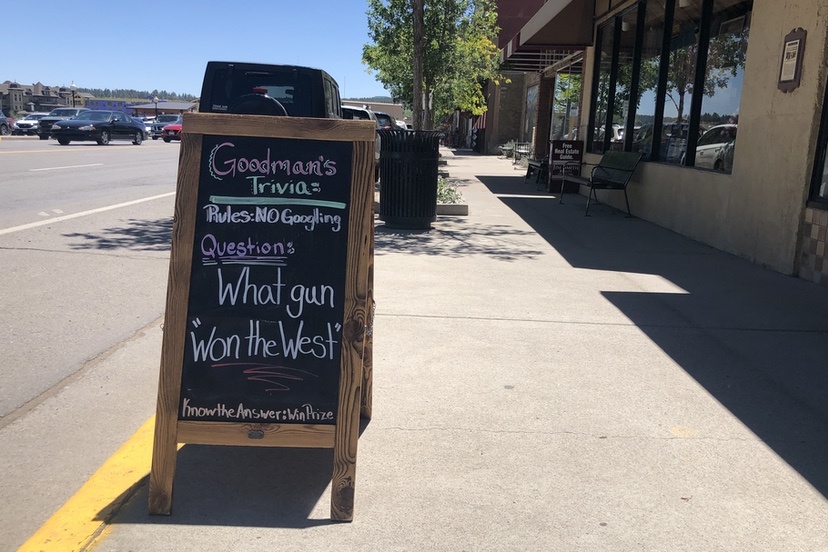Heading for Town Park with our family dog, Frida, I found myself at the stoplight at Highway 160 and Hot Springs Boulevard, and I noticed the sandwich board outside Goodman’s Department Store.
Their sandwich board often features a humorous message designed to lure you into the store, where — if you are a shopper with an attraction to high-quality western-style dry goods — you will leave with at least one purchase. Possibly more than one.
This particular message said:
Goodman’s Trivia
Rules: No Googling
Question: What gun won the West?
(Know the Answer: Win Prize)
The first answer that popped into my head was, “The Colt 45”. The Peacemaker. If I hadn’t had a dog on a leash, I might have stepped inside and tried my luck. I suppose I could have tied Frida to the sandwich board and tried to claim my prize… but I hesitated, because…
…maybe it was the U.S. military issue Springfield Model 1873 rifle?
Depends on whom you were trying to win the West from. Apparently, winning the West was a contest of some type, and it’s now over and done with.
If the contest involved a showdown at high noon outside the Crystal Palace Saloon, then you might have preferred the Colt revolver. But if you were trying to win the West from indigenous inhabitants — the Sioux, or the Comanches, or the Apaches, or the Utes — you were probably relying more on the Springfield rifle.
So the question needs a bit more definition. Were you winning the West from the outlaws… or from Native Americans?
When I was a kid, both these groups — the outlaws, and the Indians — were the enemies of decent, law-abiding settlers. Which gun killed the most enemies? I’d have to go with the Springfield rifle.
But that’s an older fictional story that many of us no longer believe. The Native Americans were once considered to be the enemies of the settlers, but some of us have embraced a different story in 2024… that, in fact, the migrating settlers, and the military that protected them, often behaved in a shameful fashion, stealing the land from its rightful owners… kidnapping Native children and sending them to boarding schools… using oppression and violence to gain possession of something to which the settlers had no moral right.
In a YouGov survey of 1,000 U.S. citizens last year, two out of three respondents said that the U.S. government did not treat the native inhabitants of North America “fairly”, and three out of four said it was wrong to forcibly remove Indian children from their families and place them in boarding schools.
But the settlers winning the West believed, and told their children, a different fictional story. Not only was the oppression and violence justified, it was Manifest Destiny.
We cannot doubt that some Americans — perhaps not many, but some — were horrified, even back then, by the way the West was won. Those Americans believed a different story, similar to the one most of us now believe.
I’ve lately been exploring the idea of fictional stories, and the stories we tell, after listening to a couple of online lectures by philosopher Charles Taylor, the author of A Secular Age, published in 2018 and a New York Times Notable Book of the Year… also a winner of a Christianity Today Book Award.
In one of his lectures, Professor Taylor addresses the concept of the ‘Master Narrative’. The overarching story.
Of course, we each have our own personal version of the story — the story of how humankind arrived at 2024, and how each of us arrived, as individuals. We each have our own story about how Pagosa Springs became the place we now experience, and we may have a story about where we believe it’s headed.
But I suspect nearly all Daily Post readers subscribe to what Professor Taylor describes as the ‘Master Narrative’. Simply stated (as I understand the term), Americans generally believe that humankind has passed through ‘stages’ of development, beginning long ago with nomadic ‘hunter-gatherers’… and then as settled, community-centered agricultural villages… and more recently, as city-dwelling consumers of industrially-produced goods and services…
Most recently, the goods and services are being provided, to an ever greater degree, by clever machines.

In our story about ourselves, these stages have been evidence of ‘general progress’. Things getting better with each stage. We can’t go back, and we wouldn’t want to go back.
Our Master Narrative includes the idea that — unlike in times past, when God was in charge of determining the direction of human development — we are now on our own, responsible for determining our own future, using the tools of science and democratic government.
We’re living in a secular age.
Yes, most Americans still subscribe to (various) religious beliefs, and we might ‘believe’ in God — but God is, so to speak, no longer running the show. Many of us accept the idea that each man or woman is basically responsible for how their individual life turns out, and if we do believe in God, He is watching and waiting, rather than actively directing human progress.
So we have to grab the bull by the horns, as it were. In both senses of the word, “bull”.
The best stories are simple, easily understood, lacking detail — again, “best” meaning “believed by many people” as if it were reality. They are not complicated, or complex, even if reality is in fact complicated, and complex.
And the best stories often involve an enemy. Preferably, a threatening, dangerous enemy. If your enemy is going to be, for example, lesbians and gays, the best story will paint these people as not merely having different values, but as being dangerous to our children. If your enemy is going to be Democrats, it’s best to depict them as “Marxists” and “socialists”. If your enemy is going to be Republicans, your best approach is to characterize them as “fascists”.
If you want to make immigrants into your enemy, the best story will portray them in exactly the manner we heard Donald Trump portray them in Part Three, yesterday.
Nobody has any idea where these people are coming from, and we know they come from prisons. We know they come from mental institutions [and] insane asylums. We know they’re terrorists. Nobody has ever seen anything like we’re witnessing right now. It is a very sad thing for our country. It’s poisoning the blood of our country…
The best stories will unite a group of believers behind a simplistic view of reality — and against an enemy.
That’s my simplistic story about the situation, in 2024.

